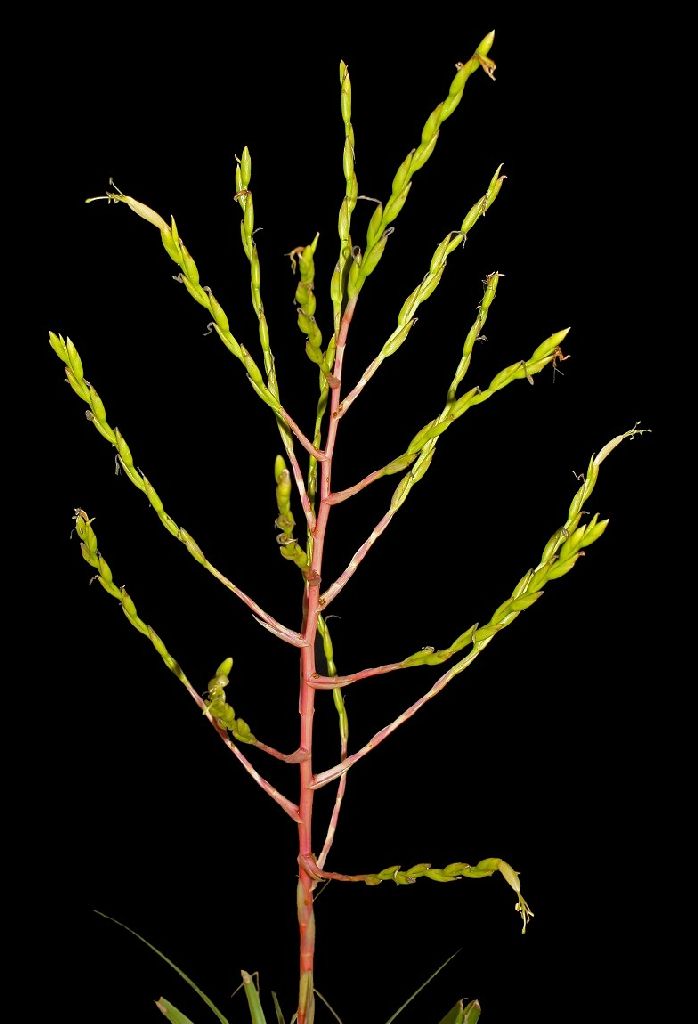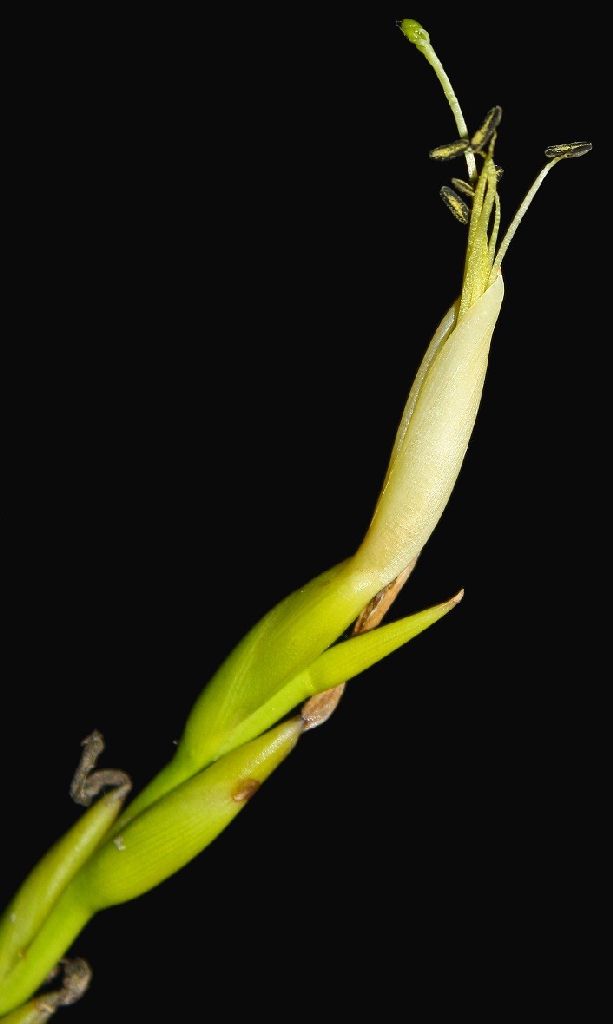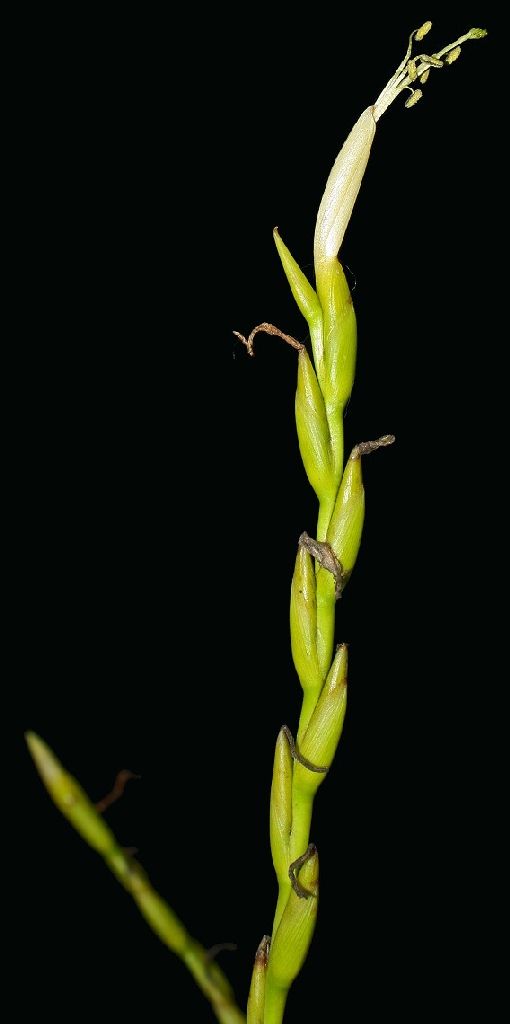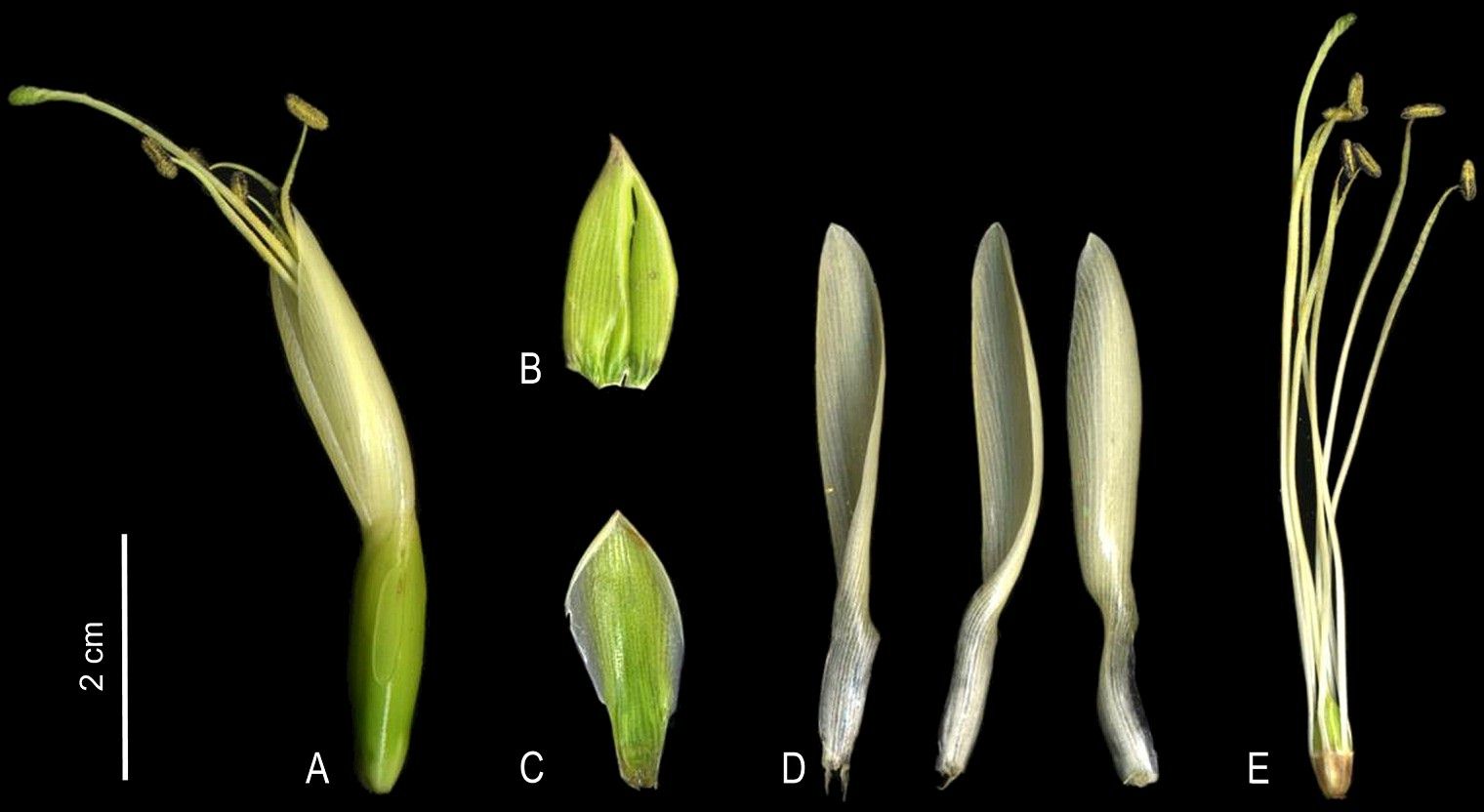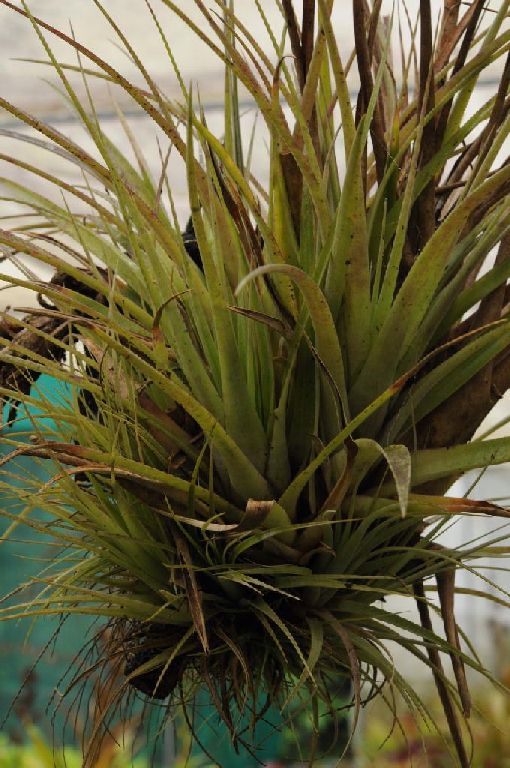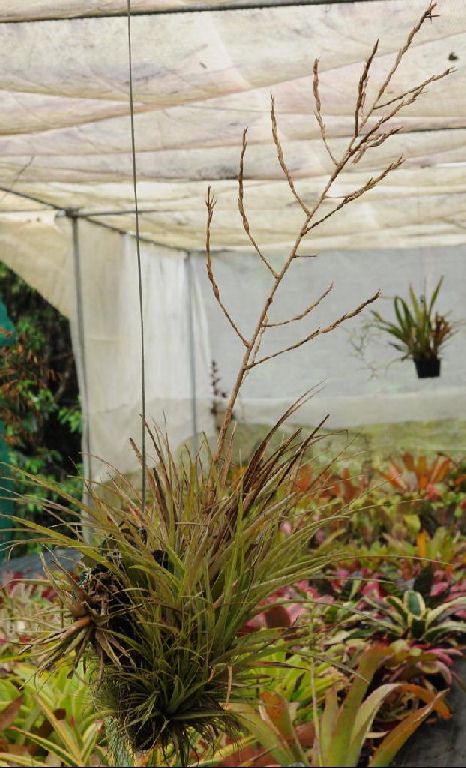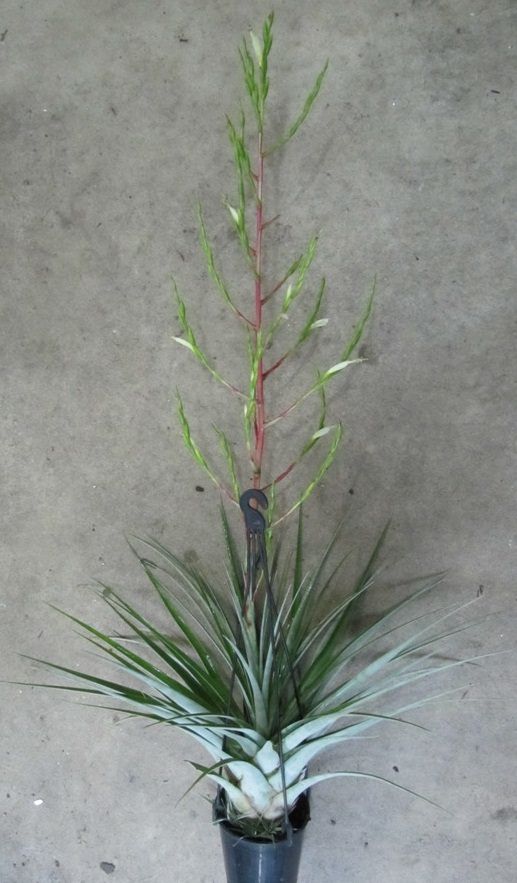
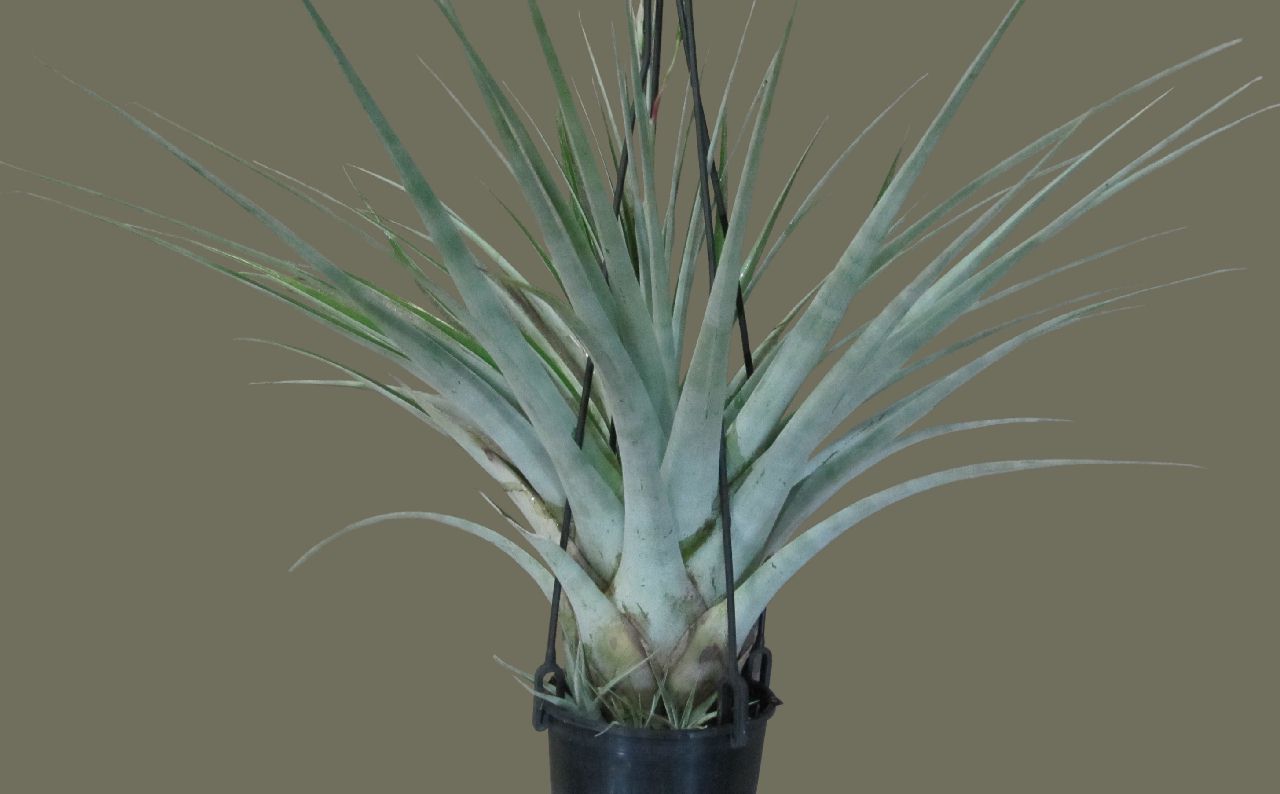
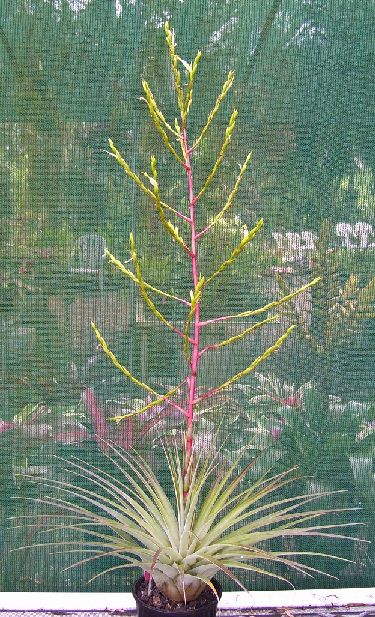
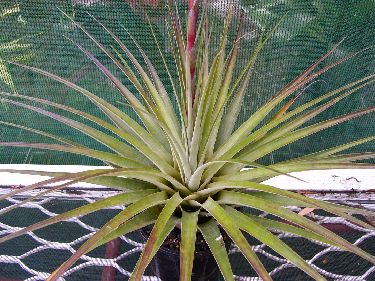
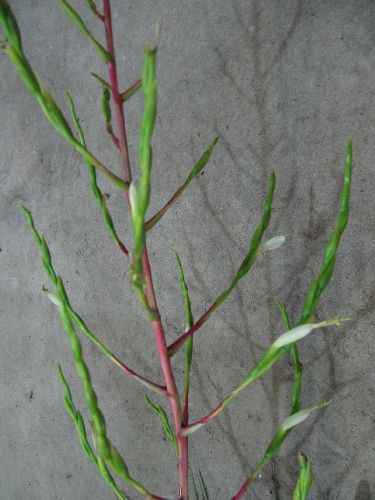
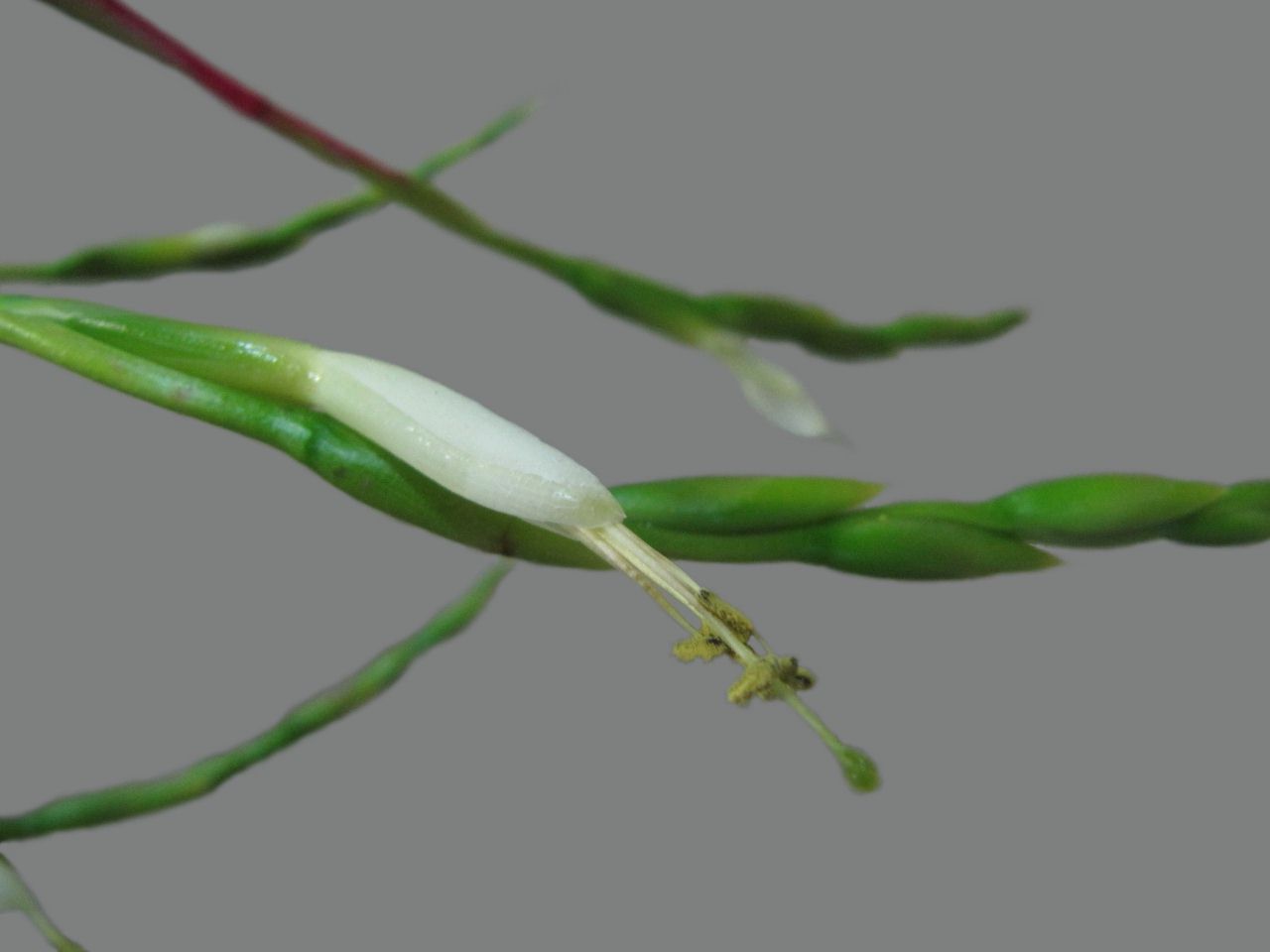
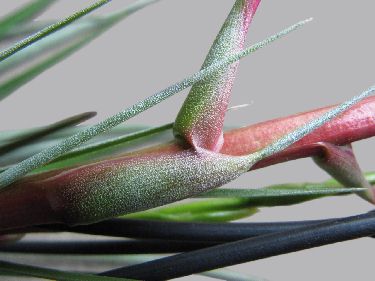
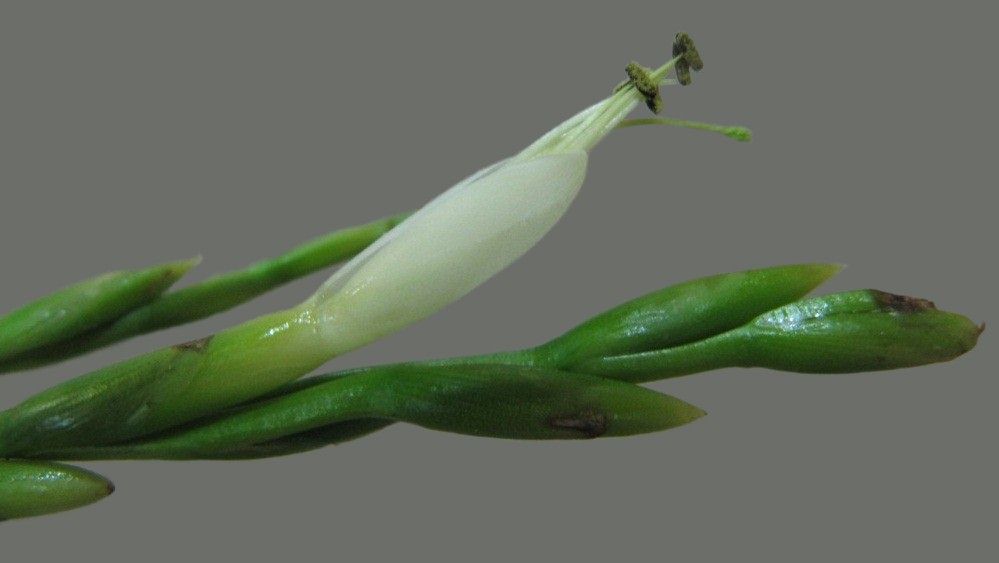
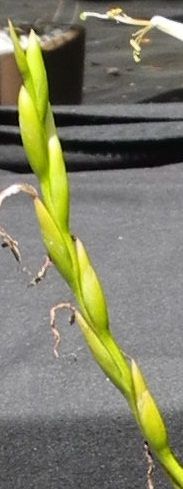

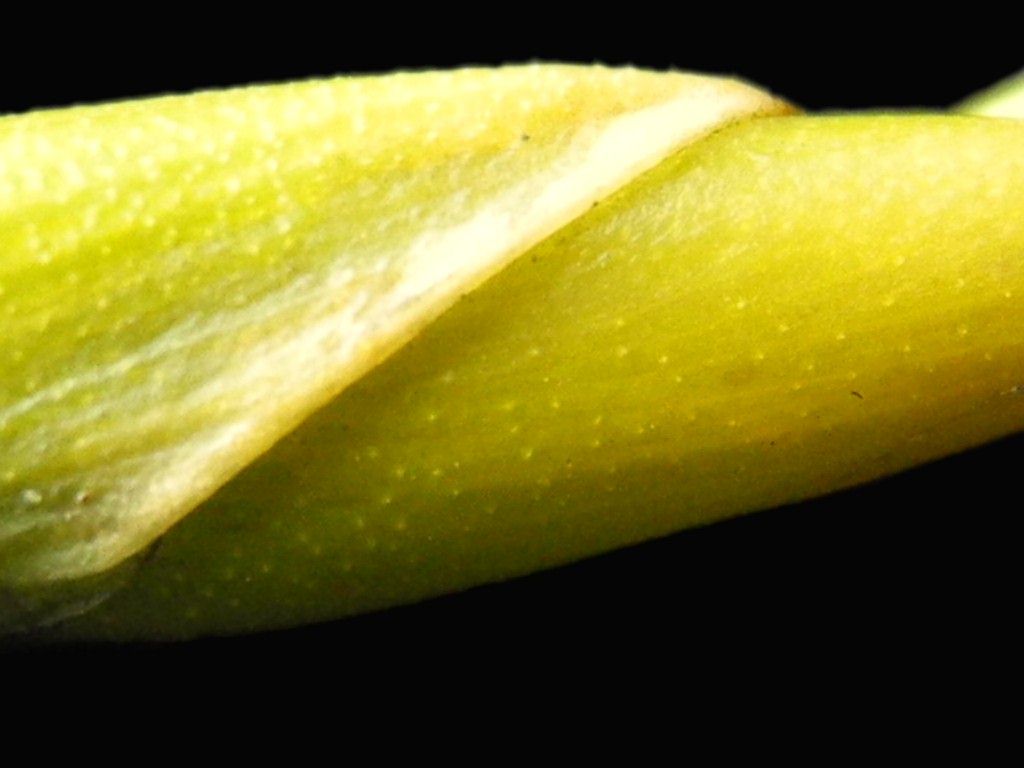
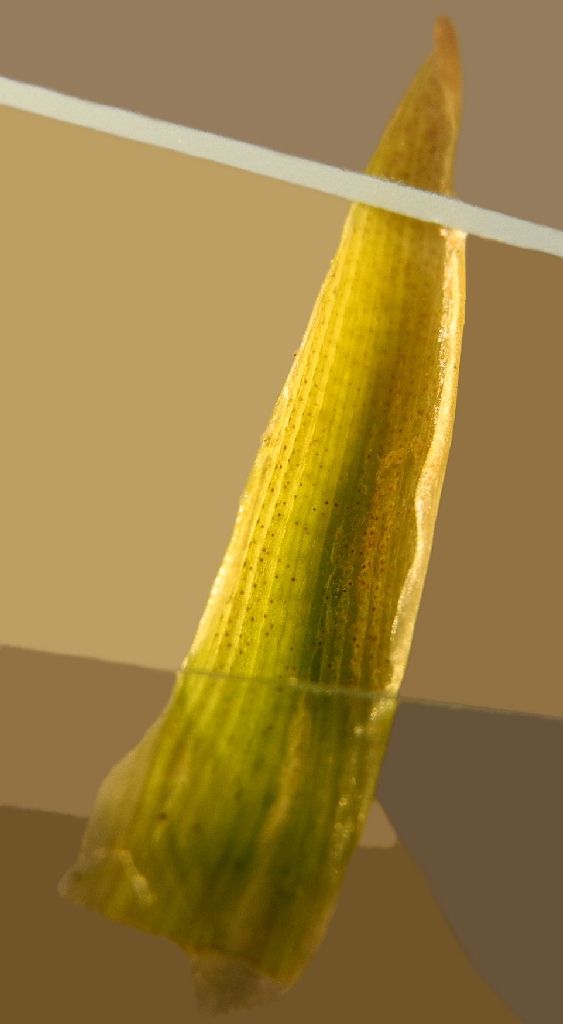

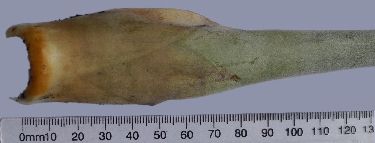
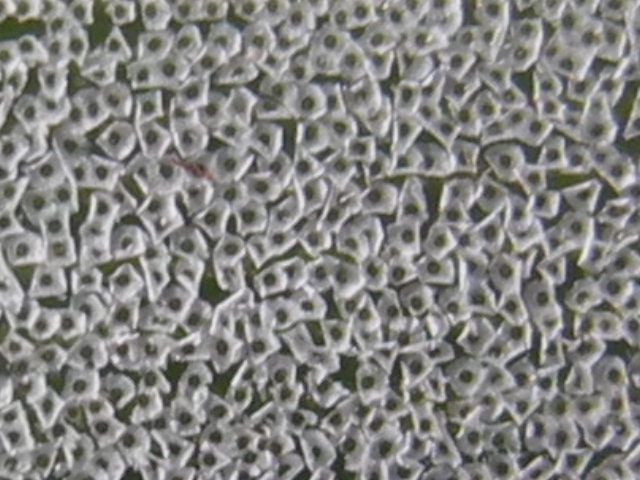
This all started when Chris Butler and Anna Stewart posted a photo of Tillandsia calcicola on ‘Tillnuts’ and I said “Whoa, it does not seem to agree with Lyman Smith’s description!” And so the investigation began.
The Butler/Stewart’s had got their plant from Bruce Dunstan who had got his plant from Peter Tristram. Peter Tristram thought it might have come from the Dominican Republic and that it might have been identified by Harry Luther, so he consulted his source who indicated he had imported it, via a European third party, from Germany in the 1980’s.
But, from what we can find out, the only prominent person growing a plant by this name was Blass, so again the lead was somewhat tenuous.
The problem here is that T. calcicola is said to be endemic to Jamaica. Ross Little also had a plant from Bruce and his was flowering too AND he was prepared to let his plant be poked and prodded by Don Beard in the cause of science.
Luckily we had Juan Pinzón to refer to. Juan is a Mexican taxonomic student currently doing a thesis on the T. utriculata group and he was able to give an insight into the problems and misconceptions within this group.
First he was having problems with T. calcicola because nobody in Jamaica seemed willing to help him. This did not surprise me because I had had similar experience with the Jamaican Botanical Garden previously where they seemed happy to take photos of herbarium specimens but appeared to have no concern for living material or its conservation. I did have some herbarium material from Renate Ehlers that Rutschmann had collected in Cockpit County in Jamaica which helped us a bit.
Anyway, the Latin diagnosis for T. calcicola by L B Smith & Proctor, emphasised the fact that the sepals had trichomes and Juan pointed out that these trichomes were on the inside of the sepals in line with all other members of the group, so it was not a distinguishing factor.
Don has found them in ‘our’ plant! He also found some intriguing white ‘pimples’ on the outer face and we have yet to find out what they are.
The leaf sheaths on the inside are said to be dark chestnut brown in dried material whereas our plant could only be called grey green with some darkish patches.
The next discussion point was that the leaves are said to be ‘attenuate to a blunt succulent apex’ which can be explained by referral to the type specimen.
The tip could easily have been broken off but the use of the word succulent suggests a certain rigidity compared to the more floppy leaves of T. utriculata.
Our plant does have leaves that can be called stiff.
We also see ‘covered with trichomes on both sides’. The leaves on our plant looked glabrous on the upper face but Don was able to prove that trichomes were on both sides, but only up to about one half on the adaxial face (upper), whereas in the top half, the trichomes were very scattered.
The description says that the inflorescence is tripinnate (twice branched) and axis straight, sometimes drying geniculate whereas the branch rhachis is geniculate.
Don reports that the inflorescence is bipinnate (once branched) and the rhachis is slightly geniculate or more precisely slightly sinuous.
Now we come to the pedicel which is the stalk between the flower and the branch. Smith says these are 5mm long but Don failed to find them. Here Juan came to the rescue because as far as he is concerned none on the group have a pedicel but rather a hypanthium which narrows to look like a pedicel in a herbarium specimen!















Tillandsia elusiva Pinzon, I. Ramirez & Carnevali. Journ. Torrey Bot Soc 138(4): 353-365. 2011
TYPE: MEXICO. Chiapas: Mpio. Ocozocoautla, a 100 m al N de la carretera Tuxtla Gutierrez - Ocozocoautla, sobre la via al aeropuerto de Ocozocoautla, 1073 m. 16°45'20"N, 93°20'20"'W, 13 Jun 2010, J.P. Pinzon, G. Carnevali, J.L. Tapia, J.C.Trejo, B. Sidoti & P. Li 103 (holotype: CICY).
Haec species a Tillandsia utriculata, cui affinis, ambito parviore, rosula infundibuliforme, non aperta, foliis argenteo-lepidotis, non viridibus, vaginis foliorum communiter atropurpureo-suffusis et spicis semper simplicibus cum internodiis proportione brevioris differt.
Epiphytic herb, 50-100 cm high when flowering, monocarpic.
Rosette funnel-shaped to spread, with 25-50 leaves.
Leaves arching to recurved;
sheaths elliptic, 7.0 -14.0 x 4.0-8.3 cm, abaxially ochraceous. densely lepidote,
trichomes appressed, hyaline to subcinereous, partially or totally covering the epidermis, adaxially ochraceous or purplish, smooth, nerved upon drying, densely lepidote but trichomes inconspicuous, appressed, hyaline, epidennis not covered completely by the scales;
blades narrowly triangular, 20.7 - 43.1 cm long, (1.8-) 2.2 - 4.8 cm wide at the junction with the sheaths, flexible, coriaceous, abaxially whitish green, finely nerved, densely lepidote throughout, trichomes cinereous, wings spreading; adaxially smooth or finely nerved upon drying, densely cinereous lepidote in the basal third, green, dispersely lepidote with trichomes hyaline or subcinereous in the central and apical thirds, apex attenuate; foliar trichomes with 4-8-16 cells, 64 radial cells, wing cells warty, margin entire.
Peduncle 23.9-39.8 cm long, 3-8 mm wide at the apex, stout, pink, with or without purplish tinges, glabrous, smooth, nerved when dried; basal peduncle bracts foliose, sheaths ovate-lanceolate, abaxially green with pinkish and purplish tinges, slightly nerved, densely cinereous lepidote, blade pendulous, apical ones lanceolate, acuminate, appressed to the peduncle, acumen erect, abaxially dispersely hyaline lepidote,
Inflorescence a panicle, once divided, erect, pyramidal; axis 9.8-32.5 cm long, 34 mm wide, vivid pink, with or without purplish tinges, glabrous, smooth, nerved when dried.
Primary bracts lanceolate to triangular, 1.7-3.9 cm long, pinkish-purplish, abaxially slightly nerved upon drying, dispersely lepidote, acute.
Spikes 6-17, (8.0--) 10.6-27.4 cm long, 1.6-2.9 (-3.7) cm apart, inserted at an angle of 90°-50° in relation to the axis, then arching upwards, with a basal sterile zone of 18-117 mm decreasing gradually toward the apical spikes;
rachis slightly flexuous to straight, 1-3 mm wide in lateral position at the central part of the spike, green with pinkish tinges, smooth, glabrous, nerved upon drying, flexible.
Floral bracts ovate, 14-25 mm long, the longest at the base of the spikes, the shortest toward the apex , 3.5-7 .1 mm wide when conduplicately folded, abaxially green with or without purplish tinges, finely nerved to strongly nerved upon drying, glabrous or dispersely hyaline-lepidote (basal ones), adaxially densely hyaline lepidote or cinereous lepidote to punctulate lepidote upon drying, apex acute, margins hyaline.
Flowers distichous, 11-25 mm apart, tending to be denser towards the apex of the spike, sessile, appressed to the rachis;
sepals lanceolate, 18-31 x 8-9 mm, basally equally short connate, abaxially green, glabrous, finely nerved, adaxially densely hyaline lepidote or punctulate lepidote upon drying, apex rounded, margins hyaline; corolla zygomorphic, hood-like (stamens and style emerge laterally opposite to a petal), oriented away from rachis, not constricted but twisted just above the apex of the ovary;
petals spathulate, 38-41 X 8-9 mm, pale cream, margins not hyaline, apex acute, connivent; stamens 47-52 mm long,
filaments rounded in cross section, concolorous with the corolla, of the same width along all their length, exserted laterally from the corolla; anthers 3.0-3.5 mm, black after opening, versatile;
ovary green, smooth, pyramidal; style 54-60 mm long, longer than the stamens; stigma pale green, lobes conduplicate, tightly spiraled, papillate.
Capsules subfusiform, 21-24 mm. long, short apiculate.
Seeds not seen.
Habitat, distribution and phenology: Interior slope of the North mountain range of Chiapas at its western end, in the surroundings of Ocozocoautla (Fig. 6). Deciduous and subdeciduous forest, at 850-1075 m. The holotype specimen was collected at 1073 m, growing on planted trees of Cedrella odorata and Tabebuia rosea. Specimens in bloom have been collected in June; immature fruits were detected in August.
Etymology. From Latin eludere: to evade, avoid; due to the fact that it was difficult to find the population, even knowing the precise locality; eventually, it was found after two unsuccessful attempts.
Affinities and diagnosis. As shown above, Tillandsia elusiva is related to T. utriculata since both are monocarpic and share the floral characters of the complex: rachis geniculate, corolla strongly zygomorphic with white or pale cream acute petals, and the stigma tightly spiraled. However, it can be distinguished from T. utriculata by its leaves of grey-lepidote appearance, the always once divided, pinkish inflorescence (Fig. 5: F, G), the adaxially nerved foliar sheaths, typically with purplish tinges, and the ratio of rachis internode length vs. floral bract length, which on an average is below one in each individual. In contrast, T. utriculata has a rosette of green or yellowish-green appearance, usually once or twice divided branches, coloration of the inflorescence green, bright red or dark purple, never pink at maturity, the foliar sheaths smooth without purplish tinges, and the ratio rachis internode length vs. floral bract length, which on an average is above one in each individual.
Tillandsia pringlei is another species within this clade, which has also always once divided inflorescence, grey lepidote leaves and shares the flower morphology, but it is profusely polycarpic, lithophytic, and has red, not pink inflorescences. It is distributed in Western Tamaulipas, Eastern San Luis Potosi, and Northern Queretaro and Hidalgo, Mexico, at least 770 km away from the type locality of T. elusiva.
Herbarium specimens of plants from Oaxaca and San Luis Potosi resembling Tillandsia elusiva have been observed (e.g. S. Gardner 217.1; US), but live specimens are required to determine whether they belong to this species.
IUCN Conservation assessment. CR (Critically endangered). Tillandsia elusiva meets
criteria B1a,b of the IUCN (2001). It is known from two localities and its extent of occurrence is of less than 100 km² (60-70 km²).The habitat of the species is currently highly fragmented by anthropogenic activities (cattle ranching and urban developments). At least one collection has been made within the Canon del Sumidero National Park, where, however, the species seems to be very rare. If the specimens from Oaxaca and San Luis Potosi that resemble T. elusiva result to be this species, its conservation status should be re-assessed.
Paratypes. MEXICO. Chiapas: 5 km East of Ocozocoautla, 3 Aug 1977, S. Gardner 212.1
(US); mpio. Ocozocoautla, 5 km East of Ocozocoautla, 3 Aug 1977, S. Gardner 212.2 (US); 5 km East of Ocozocoautla, 3 Aug 1977, S. Gardner 212.3 (US); a 21 km al O de Tuxtla Gutierrez, camino a Ocozocoautla, 3l May 1987, E. Martinez M-21486 (MEXU); Chicoasen, N of Tuxtla Gutierrez, km 21/22, Mar 1994, G. Noller s.n. (WU); a 100 m al N de la carretera Tuxtla Gutierrez Ocozocoautla, sobre la via al aeropuerto de Ocozocoautla, 13 Jun 2010, J.P. Pinzon, G. Carnevali, J.L. Tapia, J. C. Trejo, B. Sidoti & P. Li 105 (CICY).
NOTES
The Tillandsia utriculata complex has been defined as a group of species from Mexico, Central America, and the Caribbean basin characterized "by having epiphytic or subterrestrial rosettes, a monocarpic or polycarpic habit, leaves somewhat triangular, acute, never ligulate, with terminal, erect inflorescences, which are rarely racemes but more commonly 1-2 divided panicles, with flexuous and/or geniculate (bent like a knee), and sessile flowers, with stamens and style exserted from a tubular corolla" (Ramirez et al. 2004).
Besides Tillandsia utriculata, Ramirez et al. (2004) initially included in the complex the following species: T. limbata Schltdl., T. makoyana Baker, T. pringlei S. Watson, T. simplexa Matuda, T. swartzii Baker, and T. dasyliriifolia Baker. Of these, T. simplexa and T. swartzii now can be excluded, since the former is a taxonomic synonym of T. makoyana and the latter belongs in Vriesea Lindl. Ramirez et al. (2004) excluded from the complex other species with similar floral characters but different habit and vegetative appearance, namely T. albida Mez & Purpus, T. flexuosa Sw., T. calcicola L.B. Sm. & Proctor, T. cucaensis Wittm., T. fresnilloensis W. Weber & Ehlers, and T. karwinskyana Schult. & Schult. f.
Subsequently, other species were added explicitly to the complex: Tillandsia aesii I. Ramirez & Carnevali, T. pinicola I. Ramirez & Carnevali (Ramirez and Carnevali 2007a), and T. tehuacanal. Ramirez & Carnevali (Ramirez and Carnevali 2007b). In addition, other species were described by Ehlers (2006a, 2006b, 2006c), which albeit not explicitly considered as part of the complex, fit well into its definition and, in their protologues, were hypothesized to be related to taxa of the complex. These are T. comitanensis Ehlers, T. huamelulaensis Ehlers (published as T. 'huamenulaensis', but corrected here based upon the Article 60.1 of the International Code of Botanical Nomenclature (McNeill et al. 2006)), and T. nicolasensis Ehlers.
To further ascertain the composition of the Tillandsia utriculata complex, a systematic study and a phylogenetic analysis using molecular cpDNA data is currently being conducted (Pinzon et al. unpubl. data). Preliminary results from such a study strongly suggest that the Tillandsia utriculata complex is not a monophyletic group, but it is instead, composed of two clades within a larger clade of species of subgenus Tillandsia. However, the relationships of these clades are still not well resolved. The clade where T. utriculata is placed contains T. albida, T. fresnilloensis, T. karwinskyana, T. pringlei, and will be hereafter referred to as the Tillandsia utriculata complex s. str. The other clade, composed by T. comitanensis, T. cucaensis, T. dasyliriifolia, T. limbata, T. makoyana, and T. pinicola will be called the Tillandsia limbata complex.
Along with the phylogenetic analysis, a taxonomic treatment is being conducted to circumscribe the species of the Tillandsia utriculata complex. The study of herbarium specimens of T. utriculata affinity revealed some collections coming from the Mexican state of Chiapas similar to and even identified as T. utriculata and/or T. limbata, but differing from these two species. We suspected these specimens from Chiapas could represent a distinct taxon (Tillandsia elusiva hereafter), but floral characters are essential for the species identification within the T. utriculata complex, and this information was missing from the labels and not discernable from dry material. We thus planned a field trip to locate this population.
The examination of living plants of Tillandsia elusiva revealed that they bear flowers similar to those of T. utriculata while the inflorescence architecture was similar to that of T. cucaensis, which has a sympatric/parapatric distribution, and not to T. limbata (that has an allopatric distribution). We conducted morphometric analyses to assess whether the differences in sizes and proportions between T. utriculata, T. cucaensis, and T. elusiva were objective and support the hypothesis of a distinct taxon. In addition, a phylogenetic analysis using morphological characters was performed to determine whether the afore-mentioned specimens are referable to the T. utriculata complex s. str. or to the T. limbata complex. From the analyses here presented, coupled with distributional and ecological information, and additional morphological features, we expected to obtain evidence to support the hypothesis that these northwestern Chiapas populations represent a distinct species.
Materials and Methods. TAXA SELECTION.
We chose Tillandsia utriculata and T. cucaensis for comparison with specimens of T. elusiva in the rnorphometric analyses.
Tillandsia utriculata was chosen because the flowers of T. elusiva are structurally similar to those of this species. On the other hand, the overall appearance of the rosette and the coloration and architecture of the inflorescence are more similar to those of T. cucaensis, which grows parapatrically with the specimens of T. elusiva.
ANALYSES. A Principal Component Analysis (PCA) was carried out including seven specimens of Tillandsia elusiva, 11 of T. cucaensis, and 18 of T. utriculata (Table 1). The morphological characters used to perform the analysis are listed in the Table 2. Two categories of measurement density were taken, depending upon the number of the serially repeated structures.
1) Whenever possible, in the case of inflorescence associated characters, three measurements (basal, central, and apical) were recorded to assess the intrinsic variability of serially repeated structures of the inflorescence (branches, internodes, bracts) within individuals; when the structures were in numbers smaller than three, correspondingly fewer measurements were taken.
2) Some structures associated with flowers were measured up to 15 times per specimen (internodes, bracts, calyx), when available; the measurements were obtained from three branches, one basal, one central, and one apical; from the basal and apical branches, three basal, one central, and three apical structures were measured; from the central branch, one central structure was measured. The category of measurement of each character is indicated in Table 2.
Additionally, a Discriminant Analysis (DA) was performed to test statistical differences between the a priori established groups (i.e. putative species) throughout a MANOVA, which tests the hypothesis that the centroids of the groups are the same (Henderson 2006).
DA also assesses the membership of the specimens within each group according to the data, as well as the importance rank of the variables for the discrimination of the groups (Henderson 2006;). The latter analysis was performed using the same characters used for the PCA. A Canonical Analysis (CA) was conducted to visualize the position of the groups on a plane defined by the canonical roots. All the calculations were made using STATISTICA 7.0 (StatSoft, Inc)
Measurements were taken from herbarium specimens (herbaria consulted indicated in Table 1) complete enough to record all characters cited in Table 2. An additional criterion for specimen selection was to obtain an as thorough as possible geographic sampling over the distribution of the species in the analyses, in this case Mexico and the Caribbean basin.
A Fitch parsimony analysis with equal weights to character states was conducted including all the species of the Tillandsia including all the species of the Tillandsia utriculata, s. str. and the species of the T.limbata complex plus Tillandsia izabalensis ined., an undescribed species morphologically close to T. limbata. The monophyly of each complex was forced, i.e. constrained to remain monophyletic in the phylogeny, as they had been retrieved as such (BS > 88) in an unpublished phylogenetic analysis with three cpDNA regions (Pinzon et al. unpubl. data). The species whose relationships were not fully resolved (T. nicolasensis and T. tehuacana) plus T. elusiva were set as floaters, that is, they are allowed to move freely across the phylogeny, according to the characters shared with other species. Our previous phylogenetic work (Pinzon et al. unpubl. data) strongly suggests Tillandsia fuchsia W. Till (along with T. tehuacana) to be the sister taxon to the T. utriculata complex clade. Thus, this species was selected as a functional outgroup.
Forty morphological characters were used in this analysis; these are listed in Appendix I while the resulting matrix is presented in the Appendix II. The search for the most parsimonious trees was performed through an exact, exhaustive search using the implicit enumeration algorithm. To determine statistical support for retrieved clades, a bootstrap analysis (BS) was performed, consisting of 1000 iterations; here exact searches were also implemented. A strict consensus tree was calculated to summarize the topologies of the rnost parsimonious trees. All calculations were made using T.N.T.1.1 (Goloboff et al. 2003).
Trees were viewed and edited using Mesquite 2.0 (Maddison & Maddison 2007)
Results. In the PCA, the first two components accounted for 67.53% of the variance. The dots representing the different specimens here referred to particular species were not randomly distributed on the plane, but showed a strong tendency to aggregate. Points representing specimens here referred to Tillandsia utriculata clustered on the negative side of the first component. Conversely, points here referred to T. cucaensis aggregated on the positive side, while those representing T. elusiva clustered in an intermediate position around the zero point. A definite segregation of the points representing T. cucaensis and those of T. elusiva was observed. However, a single specimen, which rnorphologically was unambiguously referable to T. utriculata, falls within the swarm of points of T. elusiva (Fig. 1).
The MANOVA analysis identified the groups (species) as statistically different (Wilks' Lambda : 0.0255958, approx. F = 8.481599, P < 0.0001). The results also indicate that each group is statistically different from one another (P < 0.001) (Table 3).
The Squared Mahalanobis distances retrieved from the DA indicate that Tillandsia elusiva is closer to Tillandsia utriculata than to T. cucaensis (Table 3). In addition, the classification analysis of the cases, i.e. the assessment of the membership of a specimen to its a priori grouping, showed that all specimens clustered as hypothesized (Table 4). The most important variables to discriminate the original groups were
1 ) mean rachis internode length and
2) mean rachis width, although with low levels of significance (P > 0.12).
The distinctness of the three entities is graphically evident when the cases are plotted on the plane defined by the two canonical roots retrieved from the CA (Fig. 2).
Two equally most parsimonious trees were obtained, (length: 110; consistency index =49, retention index =60), which are summarized by a strict consensus (Fig. 3). The Tillandsia utriculata complex s. str., whose monophyly was forced, resulted well supported (BS=93).
Tillandsia elusiva was retrieved as a member of this clade, where topologically it is the sister species of T. utriculata (BS=88). Tillandsia karwinskyana and T. fresnilloensis resulted sister species as well (BS=85). The relation-ships of T. albida and T. pringlei within this clade were not resolved.
The Tillandsia utriculata complex is supported by seven apomorphic changes, of which only three are exclusive of this clade: the acute petal apex. the petal apex posture, which only in this clade is found as connivent, and the absence of the basal constriction of the corolla. Three characters support the sister relationship between T. elusiva and T. utriculata; the monocarpic genets, the floral bracts that can be entirely green, and the presence of a violaceous pigment in the floral bracts. It is important to note that these characters are homoplastic and reappear in other clades, particularly among the species of the T. limbata complex. In addition, the two latter characters are polymorphic, since different individuals of the same species can display alternative character states.
Discussion. In the Tillandsia utriculata complex, as well as in many species complexes within Tillandsia, the species can be easily recognized based on living plants.
However, diagnostic characters, such as floral morphology and colors, or the general appearance of the rosette, become obliterated when herbarium specimens are prepared. Therefore, entities that are easily recognizable from close relatives in the herbarium are most likely even more distinct in vivo.
Gardner (1984), who collected four of the seven specimens of Tillandsia elusiva studied here, proposed that plants in the population nearby Ocozocoautla in Chiapas were natural hybrids between T. utriculata and T. dasyliriifolia, based upon an analysis of morphological intermediacy tested by a PCA. However, Gardner's hypothesis presents inconsistencies.
First of all, for a hybrid to occur, the two putative parental species should grow sympatrically or, at least, parapatrically. There is no such evidence in this case and not even Gardner, who postulated a hybrid origin for the taxon, was able to document the presence of any of the parents. The nearest specimens of Tillandsia utriculata have been collected near Huimanguillo in Tabasco, Mexico, 87 krn NW of the type locality of T. elusiva. There, the species grows in a very different environment, a zone formerly covered by tropical rainforest but now mostly degraded to pastures.
The other putative parental species proposed by Gardner, Tillandsia dasyliriifolia, is even more unlikely to be involved, since this species is endemic to the Yucatan Peninsula Biotic Province sensu Carnevali et al. (2010). Tillandsia cucaensis, a species related to T. dasyliriifolia, is known to occur near the type locality of T. elusiva, but then, T. utriculata is absent. Thus, it is highly unlike that T elusiva is of hybrid origin involving any locally extant species. The possibility of an ancestral hybridization event, and subsequent introgression resulting in the obliteration of the parental species remains to be explored.
But if Tillandsia elusiva is not a hybrid, could it represent isolated populations of T. utriculata? T. elusiva and T. utriculata share several floral morphological characters, i.e. geniculate rachis, zygomorphic corollas, white or cream colored petals with acute apex and strongly spiraled stigma lobes. However, according to the results of the morphometric analyses, it is evident that they are morphologically distinct (Fig. l, 2).
Moreover, as previously mentioned, the nearest populations of Tillandsia utriculata are found to the NE and NW of the known localities of T. elusiva in tropical rainforests and consist of massive, glabrous plants, with profusely divided inflorescences. On the other hand, T. elusiva occurs in a drier environment, the plants are rather small with lepidote leaves, and the inflorescence is once divided. Thus, we conclude that these populations from north-western Chiapas are not T. utriculata.
On the other hand, it can be argued that T. elusiva is related to T. cucaensis, a species that is known to also occur in dry forests in northwestern Chiapas. However, although T. cucaensis and the new taxon share some features (i.e. grey lepidote leaves, vivid pink axis of the inflorescence, branches once, rarely twice divided), from the phylogeny it is clear that they are not related, since T. elusiva is retrieved as sister to T. utriculata (Fig. 3) while T. cucaensis belongs to the T. limbata complex. Furthermore, clear differences are observed when the flowers of both species are compared. Tillandsia cucaensis has actinomorphic corollas with green petals and stigma lobes slightly spiraled while T. elusiva features strongly zygomorphic corollas. white to pale cream petals and stigma lobes strongly spiraled, being very similar to the T. utriculata flowers (Fig. 4, 5). Thus, the characters shared between the new species and T. cucaensis could be a case of convergent evolution, perhaps driven by selection by a shared pollinator.
On the basis of all these lines of evidence, we propose this entity from northwestern Chiapas as a new species.
Tillandsia elusiva
